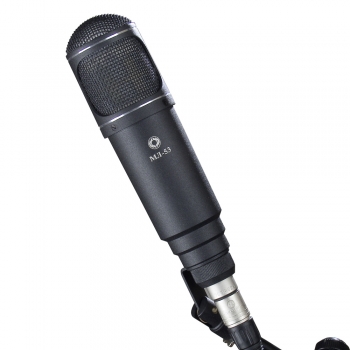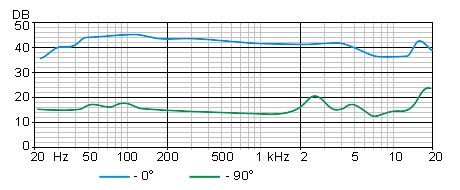 |
|
|
|
||||||||||||||||||||||||||||||||||||||||||||||||||||||||||||||||||||
Overview |
|
| This is a famous
ML-52-02 housed in a different casing and so
more open sound. Please read user feedback about this mic.
|
 |
Technical specifications |
|
| Polar Pattern | Figure of eight |
| Frequency Response | 20hz to 20kHz |
| Sensitivity | > 1,6mV/Pa |
| Aluminium Ribbon | 2.5 micron |
| Nominal Output Impedance | 300 Ώ |
| Rated Load Impedance | 1.5 k Ώ @ 300Ώ 1 k Ώ @ 200Ώ |
| Maximum SPL @ 1kHz | > 135dB |
| Maximum Output Voltage | 1,2V |
| Weight, g | 570 |
| Relative Humidity | 85% (25°C) |
| Accessories included | Mic holder |
| Accessories optional | Shock mount |
Frequency response |
|
|
User comments |
|
Experimente gemacht habe, beschloss ich, die Gitarre – wie oben gesagt – allein über das MK-220 aufzunehmen und das ML-53 für an anderen Instrumenten zu testen – und dann, wie fast zu erwarten kam die klangliche Überraschung: Für Streichinstrumente, Blasinstrumente und Percussion ein unglaublich faszinierendes Mikrofon! Ein sehr reiner Klang – alles ist da – ich konnte sämtliche Instrumente ohne EQ in den Mix einbauen. Keine aufdringlichen Frequenzen und das schönste: Ein sehr seidiger goldener Glanz ab den höheren Mitten – wow..... Sascha Schuppert-Raetzer |
|
While I'm at it, I want to tell you my
last experience with the ML 53: I had a session yesterday. Jazz combo. For the upright bass (which, by the way, sounded very good by itself), I picked up my "usual suspect", a U47 fet. And both the bass player and I were pleased with the sound, and were ready to stick to it. But the drummer was late, so I decided to try the ML 53, just out of curiosity. Well, compared to the ML, the U47 sounded midrangey! The lows of the ML were deeper, and the mids were not so hyped. In other words, with the ML the bass was ready to sit in the mix, with no further EQ! The bass player left the studio with the ML 53 references in his pocket... Gérard Lavigne at
29/09/05 |
|
Fantastic! This mic is now my ABSOLUTE first choice for electric guitar. And every guitar player I've used it on so far has noticed the difference. Put your ear in front of the speaker (noting distance and direction), find the sweet spot, and put the mic there. I've been hanging mine upside-down in a carpeted room, completely perpendicular to the floor (to avoid the bright coloration inherent in angling ribbon mics). The sound quality is amazing. The control room sounds just like the amp. Patched into an API 512C mic pre, I've been running these signals straight to tape. No EQ, no nothing, unless I need something like 1176 electronics for a little tonal coloration. Guitar players have been going nuts over these sounds. I've also had good luck recording tenor sax with it and it had an interesting quality with one male vocalist. (He liked it, I didn't.) I went out and bought another one. I'll probably get to try it on upright bass soon and I can't wait. Even before you consider that it's only $300. I purchased this mic after buying four of the Oktava MC-012s and loving them. I'm a big fan of ribbon mics and have considerable experience with the RCA 77DX, RCA 44, Coles/STC 4038, Royer 121, and Beyer M160. I find this mic to be sonically similar to the RCA 77s that I've used, with slightly higher output. Not a really brilliant top end and nice, smooth low mids. I've always loved the Coles mics, too, but I always try ro buy mics in pairs and I just haven't been able to shell out $2000 for a pair of 4038s yet. As I said I love it on guitar and my favorite setups so far have been a pair of ML-52s about 8" off of each speaker of a 2x12, one ML-52 and an AT 4047, or an ML-52 about a foot back and a pretty audacious room mic (U87, AT 4050, & AT 4047 are faves). This mic is truly a winner. Can't wait to try the tube mics! Chris Garges at 09/05/2002 |
|
What can I say other than it sounds exactly like an RCA 77DX. I've had stellar results in using it on guitar amps. I wouldn't use it for louds hard rock or metal but I don't play or record that kind of music. But...for 30-50watt amps for country, rockabilly, jazz and blues it recreates exaclty what you hear and you don't have to use nay comprssion or EQ, it's a dream. I also use it on female vocals beacuse it rolls off the highs very well, the same for males with a higher range. If you are into doing modern rock, metal or rap music this probably isn't mic for you. It also makes a great room mic, I used it for a live recording and use the Oktava as the main sound source only using the individual mics to fill up the gaps. If you can't afford a coles, beyer or an old rca ribbon then this is the mic that won't set you back in dollars or that much quality. One thing I would warn anyone interested in buying one of these is that they don't all sound the same. I was todl this before I bought mine and went to guitar center and made them fire all four of them up and listed to each one which were all a little diffrerent. Johnny Mercury at 05/26/2003 |
Application notes ML 52 |
|
General Comments: Ideal for digital recording as the noise floor is virtually non-existent. The ML 52 is also particularly useful in broadcast and installation due to the negligible sound it picks up from the sides, as well as 90 degree stereo recording Female vocal: The ML52 had a very warm and soft sound which is perfect for jazz vocals. It gives a rich sound perfect for over sibilant performers. There is an abundance of rich bottom end at very close spacing.
Steinway baby grand piano: The ML 52 produces outstanding
results on all pianos particularly Grand and Baby Grand.
Solo singing guitarist: The ML 52 sounds great on both
vocals and acoustic guitar and its figure of 8 pattern allows
flexibility when recording two sound sources at the same time in
the same space.
Electric Guitar: This mic is perfect for electric guitar
cabinets. The mic run through a good mic pre amp straight to tape
with no EQ gives amazing sound quality Brass: The ML 52 is very adept at recording brass instruments where the warm character of the sound is captured very well by the mic
Trumpets and trombone: These can both be captured with fine
clarity and detail using the ML 52, which is harder to achieve
with budget condensers
Bongos: The ML 52 gives bongos a clear and unadulterated sound
capturing the punchy attack and warm ring of the instrument
Double / Upright Bass:
Toms: see drum kit applications Clarinet and flute Steel strung acoustic guitar Nylon classical guitar |

